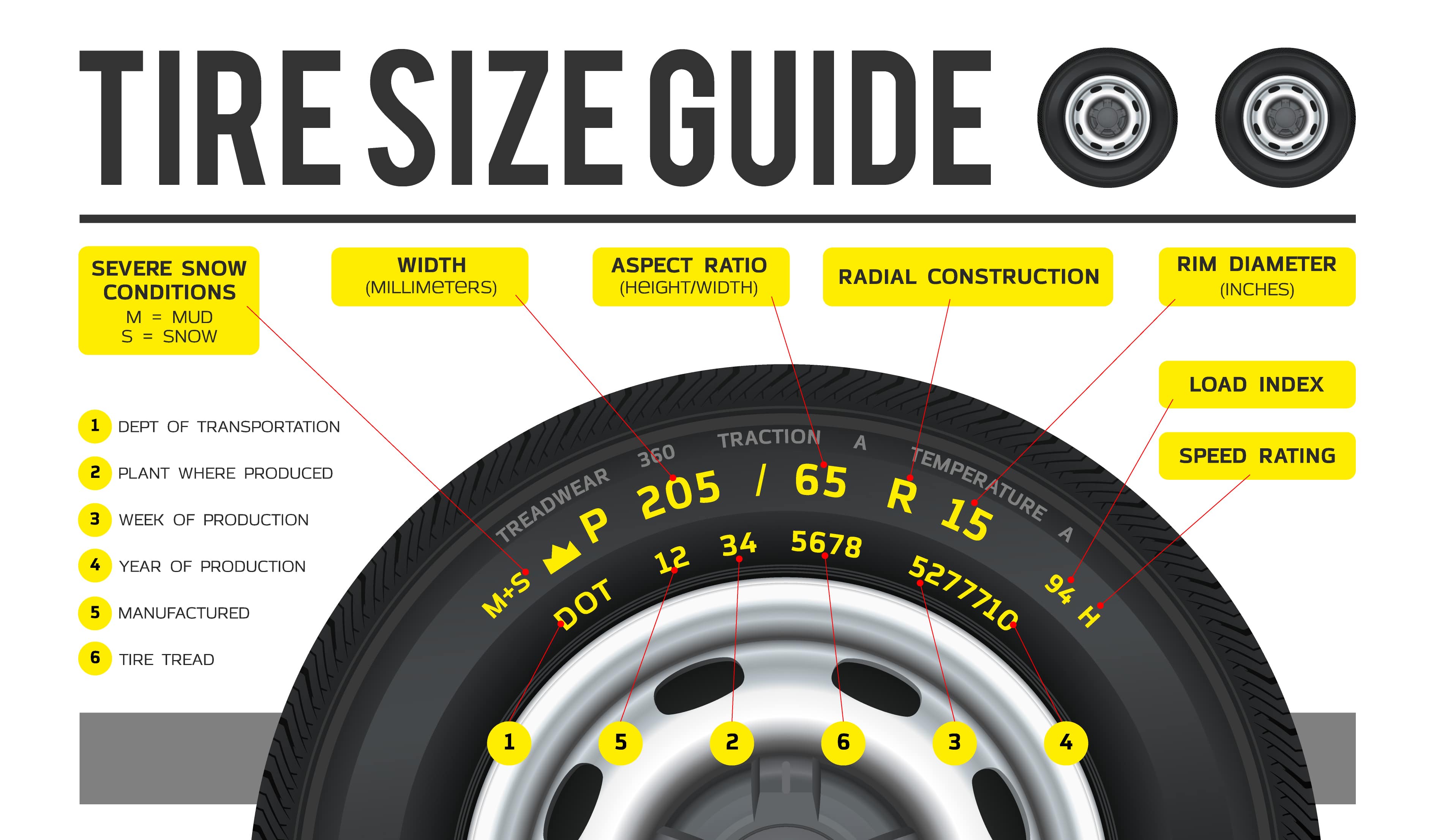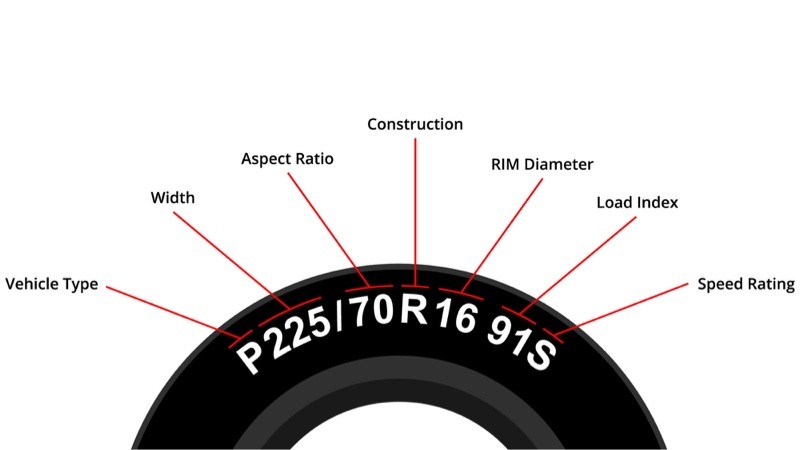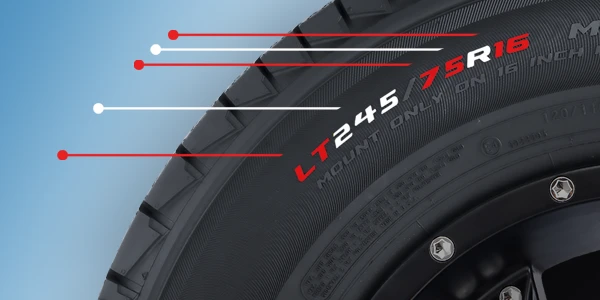Tire sizes indicate the dimensions of a tire, including width, aspect ratio, and rim diameter. These numbers are essential for selecting the right tires for a vehicle.
When choosing tires, understanding tire sizes is crucial. The size is typically represented as a series of numbers and letters on the sidewall of the tire. The first number represents the width of the tire in millimeters, followed by the aspect ratio, which is the height of the sidewall as a percentage of the width.
The letter denotes the construction type, such as “R” for radial. Lastly, the number indicates the diameter of the rim in inches. By deciphering these codes, drivers can ensure they select the correct tire size for their vehicle, ensuring optimal performance and safety on the road.

Credit: www.tireagent.com
Contents
What Do Tire Sizes Mean?
Let’s take the tire size P215/65R15 as an example. Each part of this code provides specific information about the tire’s dimensions and intended use.
1. Tire Type
- P: This letter indicates the type of tire. In this case, “P” stands for P-metric, meaning it is a tire for passenger vehicles. Other common designations include:
- LT: Light Truck
- ST: Special Trailer
- T: Temporary (Spare)
If there’s no letter, it usually signifies a Euro-metric tire, commonly found on European vehicles.
2. Tire Width
- 215: This number represents the tire’s width in millimeters, measured from sidewall to sidewall. A tire width of 215 mm indicates how wide the tire is when properly mounted and inflated.
3. Aspect Ratio
- 65: The aspect ratio is the height of the tire’s sidewall as a percentage of its width. In this example, the sidewall height is 65% of the tire’s width (215 mm), resulting in a sidewall height of approximately 139.75 mm.
4. Construction Type
- R: This letter indicates the tire’s internal construction. “R” stands for radial, the most common tire construction type. Other types include:
- D: Diagonal (bias-ply) construction
- B: Belted bias construction
5. Wheel Diameter
- 15: This number represents the diameter of the wheel (rim) that the tire is designed to fit, measured in inches. In this case, the tire fits a 15-inch wheel.
Additional Tire Markings
Beyond the primary tire size code, you may find additional markings that provide more specific information about the tire’s performance capabilities and limitations.
Load Index and Speed Rating
- Load Index: A numerical code that indicates the maximum load the tire can carry when properly inflated. For example, a load index of 95 corresponds to a load-carrying capacity of 1,521 pounds.
- Speed Rating: A letter that indicates the maximum speed the tire can safely maintain. Common speed ratings include:
- S: Up to 112 mph (180 km/h)
- T: Up to 118 mph (190 km/h)
- H: Up to 130 mph (210 km/h)
- V: Up to 149 mph (240 km/h)
- W: Up to 168 mph (270 km/h)
- Y: Up to 186 mph (300 km/h)
For example, a tire marked 95H has a load index of 95 and a speed rating of H.
Other Important Markings
- M+S: Indicates a tire is suitable for mud and snow conditions.
- 3PMSF (Three-Peak Mountain Snowflake): Signifies that the tire meets specific snow traction performance requirements.
- DOT: Stands for Department of Transportation, followed by a series of letters and numbers indicating compliance with DOT safety standards and the tire’s manufacturing details.
Understanding Tire Size for Specific Applications
Passenger Vehicles
Passenger vehicle tires (P-metric) are designed for standard cars, minivans, and SUVs. They provide a balance of comfort, traction, and fuel efficiency.
Light Trucks
Light truck tires (LT) are built to handle heavier loads and more demanding conditions. They are commonly used on trucks, SUVs, and commercial vehicles. These tires have stronger sidewalls and are available in various tread patterns for on-road and off-road use.
Special Trailers
Trailer tires (ST) are designed specifically for trailers and are not suitable for passenger vehicles. They are built to handle the unique stresses of towing.

Credit: www.bridgestoneamericas.com
Impact Of Tire Sizes On Vehicle Performance
Tire sizes play a crucial role in determining a vehicle’s performance. The impact of tire sizes on vehicle performance is evident in various aspects such as handling and speed dynamics, fuel efficiency, and ride comfort. Let’s delve into each of these factors to understand how tire sizes influence the overall performance of a vehicle.
Handling And Speed Dynamics
The size of the tires significantly affects the handling and speed dynamics of a vehicle. Larger tires offer better stability and grip, especially during high-speed maneuvers. On the other hand, smaller tires provide nimble handling and quicker acceleration due to their reduced weight. It’s essential to select the appropriate tire size based on the desired driving characteristics and the specific requirements of the vehicle.
Fuel Efficiency And Ride Comfort
Tire sizes can impact fuel efficiency and ride comfort. Larger tires may result in decreased fuel efficiency due to increased rolling resistance. However, they can enhance ride comfort by absorbing road imperfections more effectively.
Conversely, smaller tires often contribute to better fuel economy but may compromise on ride comfort, especially on rough or uneven surfaces. Balancing these factors is crucial in choosing the right tire size to optimize both fuel efficiency and ride comfort.
Choosing The Right Tire Size For the Car
Selecting the appropriate tire size for your vehicle involves considering several factors, including:
- Vehicle Manufacturer Recommendations: Always refer to the vehicle’s owner manual or the placard inside the driver’s door for the manufacturer’s recommended tire size and specifications.
- Driving Conditions: Consider the typical driving conditions you encounter, such as highway driving, city driving, off-roading, or winter conditions. This can influence the choice of tire width, aspect ratio, and tread pattern.
- Load Requirements: Ensure the tire’s load index matches or exceeds the vehicle’s weight-carrying needs, especially for trucks and SUVs used for towing or carrying heavy loads.
- Performance Preferences: If you seek enhanced handling, cornering, and stability, you might opt for low-profile tires with a lower aspect ratio. For a smoother ride, higher aspect ratios may be preferred.

Credit: www.lesschwab.com
Frequently Asked Questions
Here are some FAQs about the tire size –
What Do Tire Sizes Mean?
Tire sizes are represented by a combination of numbers and letters that indicate the dimensions, construction, and performance characteristics of a tire.
How Do I Read Tire Sizes?
Tire sizes can be read by understanding the meaning of each number and letter in the code, which represents the tire’s width, aspect ratio, construction type, wheel diameter, and load capacity.
What Is The Importance Of Tire Sizes?
Tire sizes are crucial as they determine the compatibility of a tire with a vehicle, affecting its handling, performance, and safety on the road.
How Do Tire Sizes Affect Vehicle Performance?
Tire sizes impact various aspects of vehicle performance, such as acceleration, braking, fuel efficiency, ride comfort, and traction. The right tire size ensures optimal performance in these areas.
Can I Use A Different Tire Size Than Recommended?
Using a different tire size than recommended can have consequences on vehicle performance, safety, and potentially void the warranty. It is best to stick to the manufacturer’s recommended tire size.
How Do I Choose The Right Tire Size For My Vehicle?
To choose the right tire size for the vehicle, refer to the owner’s manual or the tire placard on the driver’s side door jamb. These sources provide the recommended tire size based on the vehicle’s specifications.
Conclusion
Understanding tire sizes is essential for maintaining your vehicle’s safety, performance, and efficiency. By decoding the alphanumeric tire size codes, you can make informed decisions when purchasing new tires, ensuring they meet your vehicle’s requirements and your driving needs.
Whether you’re selecting tires for daily commuting, off-road adventures, or high-performance driving, the right tire size and specifications can make a significant difference in your vehicle’s overall performance and safety.